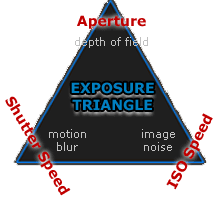Camera Exposure
A photograph’s exposure determines how light or dark an image will appear when it’s been captured by your camera. Believe it or not, this is determined by just three camera settings: aperture, ISO and shutter speed (the “exposure triangle”). Mastering their use is an essential part of developing an intuition for photography.
Exposure Triangle: Aperture, ISO & Shutter Speed
Each setting controls exposure differently:
Aperture – controls the area over which light can enter your camera.
Shutter speed – controls the duration of the exposure.
ISO speed – controls the sensitivity of your camera’s sensor to give amount of light.
One can therefore use many combinations of the above three settings to achieve the same exposure. The key, however, is knowing which trade-offs to make, since each setting also influences other image properties. For example, aperture affects depth of field, shutter speed affects motion blur and ISO speed affects image noise.
Shutter Speed
A camera's shutter determines when the camera sensor will be open or closed to incoming light from the camera lens. The shutter speed specifically refers to how long this light is permitted to enter the camera. "Shutter speed" and "exposure time" refer to the same concept, where a faster shutter speed means a shorter exposure time.
By the Numbers. Shutter speed's influence on exposure is perhaps the simplest of the three camera settings: it correlates exactly 1:1 with the amount of light entering the camera. For example, when exposure time doubles the amount of light entering the camera doubles. It's also the setting that has the widest range of possibilities:
Aperture Setting
A camera's aperture setting controls the area over which light can pass through your camera lens. It is specified in terms an f-stop value, which can at times be counter intuitive, because the area of the opening increases as the f-stop decreases. In photographer slang, which someone says the are "stopping down" or "opening up" their lens, they are referring to increasing and decreasing the f-stop value, respectively.
By the Numbers. Every time f-stop value halves, the light-collecting area quadruples. There's a formula for this, but most photographers just memorize the f-stop numbers that correspond to each doubling/halving of light:
The above aperture and shutter speed combinations all result in the same exposure.
Note: Shutter speed values are not always possible in increments of exactly double or half another shutter speed, but they're always close enough that the difference is negligible.
The above f-stop numbers are all standard options in any camera, although most allow finer adjustments, such as f/3.2 and f/6.3. The range of values may also vary from camera to camera (or lens to lens). For example, a compact camera might have an available range of f/2.8 to f/8.0, whereas a digital SLR camera might have a range of f/1.4 to f/32 with a portrait lens. A narrow aperture range usually isn't a big problem, but a greater range does provide for more creative flexibility.
ISO Speed
The ISO speed determines how sensitive the camera is to incoming light. Similar to shutter speed, i also correlates 1:1 with how much the exposure increases or decreases. However, unlike aperture and shutter speed, a lower ISO speed is almost always desirable, since higher ISO speeds dramatically increase image noise. As a result, ISO speed is usually only increased from its minimum value if the desired aperture and shutter speed aren't otherwise obtainable.
Note: Image noise is also known as "film grain" in traditional film photography.
Common ISO speeds include 100, 200, 400 and 800, although many cameras also permit lower or higher values. With compact cameras, an ISO speed in the range of 50-200 generally produces acceptably low image noise, whereas with digital SLR cameras, a range of 50-800 (or higher) is often acceptable.
Camera Exposure Modes
Most digital cameras have one of the following standardized exposure modes: Auto ( ), Program (P), Aperture Priority (Av), Shutter Priority (Tv), Manual (M) and Bulb (B) mode. Av, Tv, and M are often called "creative modes" or "auto exposure (AE) modes."
), Program (P), Aperture Priority (Av), Shutter Priority (Tv), Manual (M) and Bulb (B) mode. Av, Tv, and M are often called "creative modes" or "auto exposure (AE) modes."
Each of these modes influences how aperture, ISO and shutter speed are chosen for a given exposure. Some modes attempt to pick all three values for you, whereas others let you specify one setting and the camera picks the other two (if possible). The following charts describe how each mode pertains to exposure:
In addition, the camera may also have several pre-set modes; the most common include landscape, portrait, sports and night mode. The symbols used for each mode vary slightly from camera, but will likely appear similar to those below:
However, keep in mind that most of the above settings rely on the camera's metering system in order to know what's a proper exposure. For tricky subject matter, metering can often be fooled, so it's a good idea to also be aware of when it might go awry, and what you can do to compensate for such exposure errors.








informative & impressive (y)
ReplyDelete